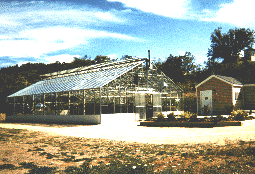Established in 1995 this project was a joint venture between the
Municipality of Annapolis County, Government of Canada the Province of Nova Scotia.
Currently owned by The Municipality of Annapolis County the plant is the first solar
aquatic treatment facility in the country and the first full-scale plant in North America.
Applied Environmental Systems (a Nova Scotia Company) was responsible for the design and
construction of the facility and continues to offer technical support and expertise. This
project has attracted interest from both the scientific and environmental communities with
the facility being the recipient of the "1995 Sustainable Communities Award".
owned by The Municipality of Annapolis County the plant is the first solar
aquatic treatment facility in the country and the first full-scale plant in North America.
Applied Environmental Systems (a Nova Scotia Company) was responsible for the design and
construction of the facility and continues to offer technical support and expertise. This
project has attracted interest from both the scientific and environmental communities with
the facility being the recipient of the "1995 Sustainable Communities Award".
The Bear River Solar Aquatics Wastewater Treatment Facility is a wastewater treatment system that functions in
a greenhouse. The facility at Bear River is 2400 square feet and contains a dozen solar
tanks as well as a solar pond. The solar tanks are home to a variety of plant life as well
as bacteria, snails and fish. The purification of the wastewater starts with what is
called the blending tank. Here the solids in the wastewater are broken up and bacteria are
added. This process, known as bioaugmentation, is used to aid in converting the wastewater
to prime material for the ecosystem to feed on. By breaking up the solid material the
facility avoids producing sludge like conventional systems, which allow the solids to
settle out. At this stage the water is also aerated, with the increased oxygen levels in
the water enhancing and accelerating the process.
There are presently twelve solar tanks measuring 5 feet by 6 feet
in diameter. The tanks are gravity fed from one to the next, with each tank being a mini
ecosystem. Inside each tank there is algae, zoo plankton, phytoplankton, snails, fish and
specially selected plants that feed on the organic compounds in the water. As the
wastewater progresses from one tank to the next, more and more of the organic compounds
are removed.
 After the wastewater has passed through all twelve solar tanks it
flows into a 31 foot by 19.5-foot solar pond which is 9.5 feet deep. The pond has three
sections separated by hanging baffles and contains the same ecosystem as the solar tanks
only larger. The consumption of organic material continues here and the water is further
aerated to again increase oxygen levels.
After the wastewater has passed through all twelve solar tanks it
flows into a 31 foot by 19.5-foot solar pond which is 9.5 feet deep. The pond has three
sections separated by hanging baffles and contains the same ecosystem as the solar tanks
only larger. The consumption of organic material continues here and the water is further
aerated to again increase oxygen levels.
Some of the affluent is pumped into a marsh where the various
species of marsh grass act in the processes of denitrification, nutrient uptake, and
removal of phosphorus and final "water polishing". The water is then passed
through a "swirl separator" and a "rotary drum filter" where any
remaining solids are removed and digested aerobically in underground stabilizing tanks and
then applied to a "reed bed" compost. The affluent is then UV disinfected and
gravity fed into the Bear River Estuary. While the "reed bed" is in place to
deal with any remaining solids that may still be present at the end of the process this
has never been required. The final result is water that meets or exceeds Nova Scotia
environmental standards processed chemically free in an odorless and lush environment.
The Bear River Solar Aquatics Wastewater Treatment Facility is currently configured to process 15,000
imperial gallons of wastewater per day or over four million imperial gallons a year. At
the time of construction the facility was designed to make expansion of the facility as
easy and cost effective as possible. The more complicated and expensive components of the
facility were purposely built to exceed current needs and requirements. To increase the
processing capabilities of the facility only the greenhouse would have to be enlarged. It
is also easy to upgrade the system to clean the affluent to a higher quality. The mini
ecosystems may appear fragile and vulnerable to agents such as toxins to the untrained
eye. However the high degree of diversity through out the system allows it deal with
agents such as toxins as a complex group. Other systems rely on a few specialized
micro-organisms that may fall victim to a toxin(s) shutting those systems down.
The public is encouraged to visit Bear River and
tour the facility. It is open from mid June to mid September Monday
to Friday one p.m. to five p.m. and noon to five p.m. on Sundays.
You may also make an appointment to tour the site by calling 1-902-467-3774
or visit their site at http://www.annapoliscounty.ns.ca/solaraqu.htm
or if you have more questions please contact Environmental Design
and Management Ltd. at info@edm.ca




